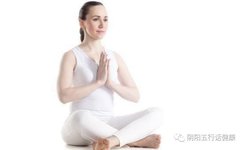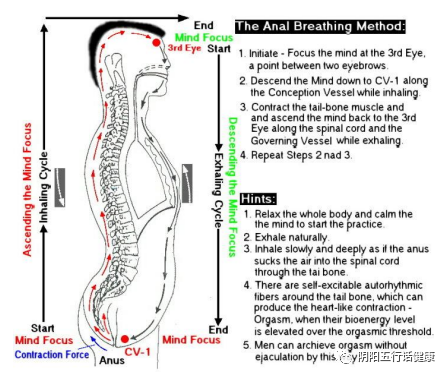
In Chinese, “Qigong” refers to the practice of working with Qi (vital energy) as it transforms into air and biological energy. Qigong is essentially the work of Qi. It is a natural abdominal breathing technique that mimics the breathing of infants, where one tightens the coccygeal muscles during each deep inhalation. Ancient Taoist teachings defined this technique as the “anal breathing method” because the founder of Qigong could feel the Qi being drawn in through the anus to the spinal cord or aorta. To practice this technique, one must half-close their eyes and focus on the coccyx, relaxing the muscles during natural exhalation.
The coccygeal muscles act like a pump, driving Qi from the initial point, CV-1 (Ren 1), through the anus to the spinal cord and aorta. The primary source of Qi is the performance energy center, ejaculation control valve, or epicenter. The anal breathing method is a Taoist meditation that does not require a specific posture; it can be practiced in any relaxed position. This meditation method guides the mind into a semi-conscious state to promote the parasympathetic function of the autonomic nervous system while also directing performance energy from the sexual organs to the spinal cord and aorta. A good practitioner can feel a warm current flowing along the spinal cord and aorta. For men, it can transform sexual stimulation energy into erectile power. Ancient Taoists used this anal breathing method to practice the natural penile enlargement balloon method. If a man does not experience premature ejaculation during intercourse, he can use this method to prolong the duration of sexual activity, allowing him to draw performance energy from the woman’s epicenter while rhythmically massaging around the natural nerve fibers of the woman’s epicenter. This is essentially a method for enhancing the penis.
The anal breathing method can be applied to drive Qi in concepts and control the circulation of blood vessels, as described below. This is called the micro-circulation of Qi. You can practice this micro-circulation by following these steps: 1. Focus on the third eye area between the eyebrows and calm your emotions with natural breathing. 2. As you naturally inhale, direct your attention down the conceptual blood vessels to CV-1. 3. As you slowly exhale, gently contract the coccygeal muscles a few times, and with each exhalation, let your attention rise along the spinal cord and governing vessels, eventually returning your focus to the third eye. 4. Continuously repeat steps two and three.
If sufficient biological energy is stored in the sexual organs, practicing micro-circulation can guide a warm current (Qi) to circulate around the governing and conceptual vessels. It takes 3-12 months of training for a person to experience the micro-circulation of Qi. In ancient times, both male and female Taoists utilized the micro-circulation of Qi to eliminate the urgency of sexual intercourse. Thus, Taoists believed that the micro-circulation of Qi is akin to the “return of sperm to the brain,” referring to recharging the central nervous system (CNS) with biological energy around the prostate or epicenter. Men can use this practice to alleviate their sexual cravings during their partner’s menstrual period while also allowing for temporary cessation of sexual activity. In fact, if the automatic rhythmic fibers of the coccygeal muscles are stimulated and synchronized with anal contractions at a rate of 75 per minute or 1.25 per second, the anal breathing method can produce a climax without ejaculation under normal heart rhythm. The anal contractions must be gradual (stair-step) and very light, so as not to disturb the muscles around the prostate. Generally, each inhalation should be accompanied by 3-10 contractions or vibrations at the same rate as the normal heartbeat. Forced contractions can induce vibrations in the natural rhythmic fibers in a very short time. A man can achieve 3-10 climax contraction cycles through this method. Women can also apply this method by performing deep contractions with each inhalation to maximize sexual response in their vaginal and coccygeal muscles. Perhaps women who have undergone a hysterectomy should integrate this method with intercourse to help them achieve climax. Clearly, a hysterectomy disrupts the automatic rhythmic fibers between the cervix and bladder. When their biological energy rises to the climax limit, these fibers can be excited on their own, adjusting uterine contractions like the automatic rhythmic fibers of the heart. They can recharge from the biological electrical system (endocrine system, ANS, and acupuncture therapy) to achieve good sensations or intercourse. Here, I encourage you to first practice the anal breathing method. This way, you can smoothly transition from the simple anal breathing method to the more complex practice of sexual Qigong. Sexual Qigong combines the legendary Taoist Qigong with the principles of biophysics and neural conflict, and is a practice that involves controlling breathing to perform synchronized contractions or expansions of the lower abdomen, exercising the muscles around the reproductive organs and internal sexual organs. The exercise of these muscles will hinder the local sensory nerves’ response to stimulation. Additionally, because the acupuncture meridians converge in the reproductive area, some internal sexual organ meridians are submerged, and the lower limb cavities are interconnected. Practicing the lower limb cavities and internal sexual organs not only strengthens the muscles around the sexual organs during intercourse but also increases the circulation of blood and Qi (biological energy) around the reproductive organs. Note the surface acupuncture therapy diagram; it is also a practice related to the mind and body, helping to control attention or focused responses. Biological energy is produced by the secretions of the adrenal glands located atop the kidneys, distributed to the other 12 meridian points through the conceptual and governing vessels. Heating, cooling, or massaging these two vessels will affect the biological electrical production of the adrenal glands, impacting the Qi index of the kidneys and liver. In fact, these four vessels influence each other. In hot temperatures or during summer, the body is activated by external energy due to the heating of the governing and conceptual vessels; whereas in low temperatures or during winter, we tend to be quieter and lose less biological energy to the outside world because these two vessels are cooled. This is why elderly individuals tend to pass away more in winter than in summer. In fact, short-term cold climate changes can immediately affect the biological energy index of internal organs through acupuncture therapy. It can disrupt the kidneys and liver, leading to a lack of DHEA and testosterone in areas of joint or blood circulation. Therefore, when they lack hormonal support for local metabolism, the local nerve cells in these weakened blood circulation areas respond to climate changes with pain. Pain is a signal that local cells lack hormones, while numbness is a manifestation of blood congestion. Warming the body can temporarily resolve these issues. The long-term solution to the problem is to remove local blood congestion and restore the vitality of the hormonal generation system. This is how the body and the external environment influence each other. Additionally, sunbathing is more invigorating for sexual activity than other methods because frequently heating the governing and conceptual vessels stimulates the adrenal glands to produce DHEA. The result is a sharp increase in the secretion of sex hormones. However, when a man or woman overheats their governing vessels, they will experience fatigue from the heat. The influence of the adrenal glands on the governing and conceptual vessels is evident; heating (or cooling) these two vessels will instantaneously promote (or quiet) adrenal function, thereby altering the output of DHEA and testosterone in the endocrine system. In TCM theory, back pain is due to a lack of DHEA or a deficiency of sex hormones in the painful area. It is also caused by structural blood congestion in the subcutaneous or muscular tissues, blocking the circulation of blood and Qi, or the concentration of blood congestion in nerve cells. If a person suffering from back pain warms the governing and conceptual vessels, it will immediately alleviate or eliminate the pain. In fact, warming the governing and conceptual vessels allows the adrenal glands, kidneys, liver, and sexual organs to recharge with heat through acupuncture therapy. This ignites the endocrine system to produce more DHEA and testosterone. Therefore, even if there is some obstruction in the circulation of blood and biological energy, hormones can still extend to the hot spots to relieve pain. In fact, this is my personal practice against the transition period of middle age. In 1992, I suffered from severe back pain, and I used a heating pad on the governing and conceptual vessels to alleviate the pain for sleep. I found that heating the governing vessels was more effective than the conceptual vessels. Later, I tried to use TCM to increase the production of DHEA and sex hormones. This is detailed in Chapter 8 of my medical book. An hour after taking the medication, I felt a continuous warm current circulating in the governing and conceptual vessels, radiating from the pelvic cavity to every part of my body. Increasing DHEA and sex hormones can immediately eliminate back pain, but it also diminishes sexual desire. The result means that the contracting muscle cells need hormones to support local metabolism. Finally, I invented the vacuum cupping method to transfer blood congestion, thus eliminating pain, as described in Chapter 7. Therefore, I resolved my back pain and numbness issues. However, I still experience slight stubborn pain in certain areas of my body during winter. From earlier experiences and TCM tonics, I have added herbal supplements that can promote the functions of the endocrine, nervous, and blood circulation systems, restoring my daily health. Thus, I discovered a method to combine the endocrine and blood circulation systems to recharge the nervous system. The practice of sexual Qigong is part of my invention, applicable to the alternating sympathetic and parasympathetic functions within the autonomic nervous system. I refer to the progressive (the term is “stair-step”) inhalation method for men’s sexual Qigong as Tai Chi Yin Gong. This inhalation technique originates from an ancient Buddhist breathing method. It was used to calm the sexual excitement of monks and nuns. It helps maintain kidney Yin Qi and supports life force. I suggest men follow these four steps, as outlined in the chart below:
1. Calm your emotions with a few minutes of natural breathing, half-close your eyes, press your tongue against the roof of your mouth, and focus your mind on the forehead area between the eyebrows. 2. Gradually inhale through the nose, allowing the abdomen to expand, a process referred to as “suction,” and hold your breath for 2-5 seconds, using your lungs to their maximum capacity for 8-20 times, shifting your attention to the navel. 3. Hold your breath, begin to contract the upper abdomen, shifting the expanded abdomen downward, and when the pressure gradually blocks the bladder and prostate, shift your attention to the prostate area. 4. When related to the anus, slowly exhale through the mouth, as your attention gradually shifts from the prostate area along the spinal cord to the forehead. 5. Repeat steps 2-4 several times. Note: 1. In step 4, men should feel a warm current flowing from the prostate area upward along the spinal cord to the head. 2. During intercourse, step three is the most important; he should try to hold his breath for as long as possible and apply pressure, maximizing the upper abdomen’s resistance against the bladder and prostate while fully expanding the lower abdomen. This will dull the sensitivity of the penis, ultimately leading to a loss of sensation, as if preparing for surgery. Once accustomed to this breathing technique, or as he ages, he will eventually no longer need to maintain maximum expansion of the lower abdomen. Applying slight pressure on the bladder will allow him to have good control over ejaculation. In fact, if he is a practitioner of Qigong, he can simply use the Anal Breathing Method to control ejaculation. 3. During intercourse, the progressive inhalation, along with the bladder or anus or rectum, should be synchronized with the thrusting during intercourse.
For women, I define the breathing method as Tai Chi Yang Gong. I derived this method from the ancient Taoist breathing techniques used to enhance kidney Yang Qi and invigorate life force. The procedure is as follows: 1. Calm your emotions with a few minutes of natural breathing, half-close your eyes, press your tongue against the roof of your mouth, and focus your mind on the navel area. 2. Slowly exhale through the mouth, fully expanding the abdomen and emptying the lungs, shifting your attention to the forehead area between the eyebrows. 3. Gradually inhale through the nose, also defined as suction and holding, while connecting the upper abdomen with the vagina/anus, holding for 2-5 seconds, using your lungs to their maximum capacity for 5-15 times, shifting your attention from the forehead down along the spinal cord to the vaginal area. 4. Maintain maximum contraction of the vagina/anus for 10-100 seconds.
5. Repeat steps 2-4 several times. Note: 1. In step three, women will feel energy flowing down the spinal cord to the vaginal area. 2. During intercourse, step four is the most important, as it maximizes vaginal sensitivity, breaking through climax barriers, allowing her to begin experiencing a warm current flowing from her sexual organs up to her chest and then to her forehead. 3. During intercourse, the gradual inhalation, accompanied by periodic contractions of the vagina, should synchronize with the thrusting until she reaches the climax barrier and changes steps.
In practicing sexual Qigong during intercourse, generally, the sexual arousal of women lags behind that of men, unless she is very sensitive. This difference can lead to premature ejaculation in men, which is a common issue for most men. Young men may become overly excited during intercourse. When I was younger, I initially practiced deep breathing to stabilize my emotions. Gradually, to shift excitement from my penis to my bladder and anus, I learned to expand my lower abdomen. As long as during intercourse, although continuous stimulation made my penis very hard, practicing sexual Qigong breathing while maintaining the expansion of the lower abdomen prevented sexual stimulation from reaching my brain, allowing me to completely block the transmission of sexual stimulation in the genital area. It seems that expanding the lower abdomen also creates internal pressure in the bladder and anus. My autonomic nervous system, through the sexual Qigong breathing with the expansion of the lower abdomen, is tricked by the reaction of the bladder and anus, so the stimulation received by the penis and prostate does not reach my brain. If I practice for 20 minutes during intercourse, my penis becomes numb but remains hard. Thus, I can completely lock the ejaculation valve using this method. Once the penis becomes limited, the brain receives other sexual stimulation signals from the penis, then there is no need to continue practicing sexual Qigong. Almost all sexual positions allow you to practice sexual Qigong. However, those who can elevate their penis to the 12-3 o’clock position should use sexual Qigong to lock the ejaculation valve before using positions that do not directly stimulate the man. Those who cannot elevate their penis to the 3 o’clock position should use calm attention and rotational techniques to stimulate the penis. Even with rotational techniques, they can still practice sexual Qigong to awaken the penis.
In intense movements, sexual Qigong is crucial for obstructing the penis’s response to stimulation. For example, during intercourse, how both partners can practice sexual Qigong to lock the ejaculation valve and accelerate her sexual response.
Applying sexual Qigong to stimulate the three-point position is also very important, allowing the woman to swing at the fastest speed (2.5 cycles per second) and accompanied by impact (inertia and pressure, above 100 pounds). The following images show how men use sexual Qigong to obstruct the dynamics caused by the woman’s swinging.
In this case, when the woman contracts her vaginal muscles with her abdominal muscles, the male reproductive area continuously pumps and holds air in sync with the woman’s swinging.
This movement allows her to achieve explosive orgasms at a rate of 20 times per minute.
Congratulations on discovering the secret points of the female body.
Deep within that point – the epicenter.
The epicenter is the female prostate.
You must penetrate the vagina to reach the small cavity (depression) located between the cervix and bladder.
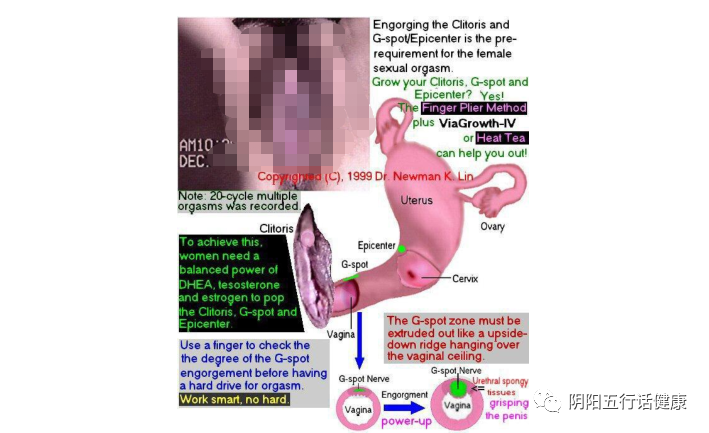
If she is very excited, the mid-section of the vagina (about 2-3 inches long) will be wide, with a diameter of about 3 inches, while the G-spot is located about 1-3 inches inside the vaginal opening. Your penis glans will not feel anything in the middle area unless your penis is at a very high angle of erection – where the glans can apply high-pressure stimulation to the G-spot and the epicenter’s urethral nerve.
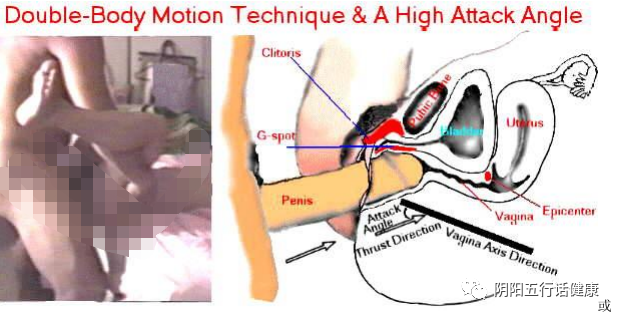
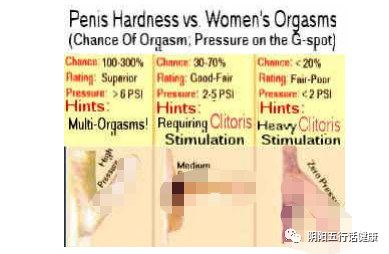 Imagine her lying on the bed, very excited, while you “walk” into her vagina.Starting to penetrate her jade gate (vaginal opening), you can see her bulging G-spot, about 1-2 inches long, hanging down from the top wall of the vagina.About at the end of the G-spot bulge, her vagina is about an inch wide (in diameter).As you penetrate 2-3 inches, you will encounter a round structure (cervix), where there is a tiny passage leading to her uterus, where a child will begin to grow from an invisible fertilized egg.But do not enter here.It is too small for the glans to enter.However, during dog mating, the long and small dog penis can enter the female dog’s uterus, and then the dog’s uterus will grip the penis.This is called a tie.
Imagine her lying on the bed, very excited, while you “walk” into her vagina.Starting to penetrate her jade gate (vaginal opening), you can see her bulging G-spot, about 1-2 inches long, hanging down from the top wall of the vagina.About at the end of the G-spot bulge, her vagina is about an inch wide (in diameter).As you penetrate 2-3 inches, you will encounter a round structure (cervix), where there is a tiny passage leading to her uterus, where a child will begin to grow from an invisible fertilized egg.But do not enter here.It is too small for the glans to enter.However, during dog mating, the long and small dog penis can enter the female dog’s uterus, and then the dog’s uterus will grip the penis.This is called a tie.
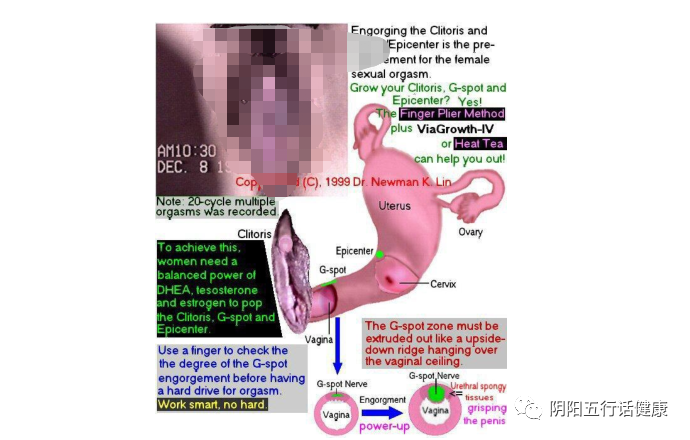
Note that the female dog’s vagina and urethra are indeed mixed together (called the urethra-vaginal canal?), so the male dog’s penis can directly stimulate the female dog’s vaginal nerves. For humans, the female vagina and urethra are separated by a layer of sponge tissue, where the G-spot is hidden. In fact, the G-spot nerve is part of the urethral nerve. The G-spot bulge is equivalent to the male sensitive area. Assuming you cannot enter the uterus, conversely, you climb up to the round structure, you will find a tiny depression at the end of the vagina, bordered by the bladder wall and cervix. If you stimulate the epicenter, she will respond wildly. As shown in the massage, you can easily reach the epicenter.

If she supports herself with her legs while squatting, the force of gravity can shorten the vagina. Your glans will more easily reach her depression. If you get there, you will feel that depression has a pulling force, just like a cosmic black hole.
If she sits upright or leans back, her vagina will be shorter, and her vaginal walls will be oval-shaped. The oval vagina will exert special pressure on the lower part of your penis. If you move your glans along the path of stimulating her clitoris from the G-spot bulge to the depression, back and forth several times, she will climax like a volcano erupting. In fact, you need to stimulate her entire urethral nerve from the vaginal wall. The G-spot and epicenter are the areas where the urethral nerve is most concentrated. The clitoral glans consists of the urethral nerve branches responsible for parasympathetic erectile function (S2-S4) and sympathetic climax (L1-L2) and extends from the cervical area (C1) to the body’s anterior midline via the vagus nerve (parasympathetic erection).
Simultaneously stimulating the clitoris, G-spot, and epicenter is called the three-point stimulation method. You can also use my finger pinching method, stimulating the urethral nerve from the G-spot to the epicenter with one finger while the other fingers act on the clitoral shaft and its sides, applying rotational in-and-out movements against the G-spot and the sides of the clitoral bulge. The speed and pressure of stimulation are also important. To apply strong stimulation, ensure that her clitoris, G-spot, and entire labia are wet, while her vaginal walls tighten and extend. Additionally, stimulating the epicenter may cause pain or cramping.
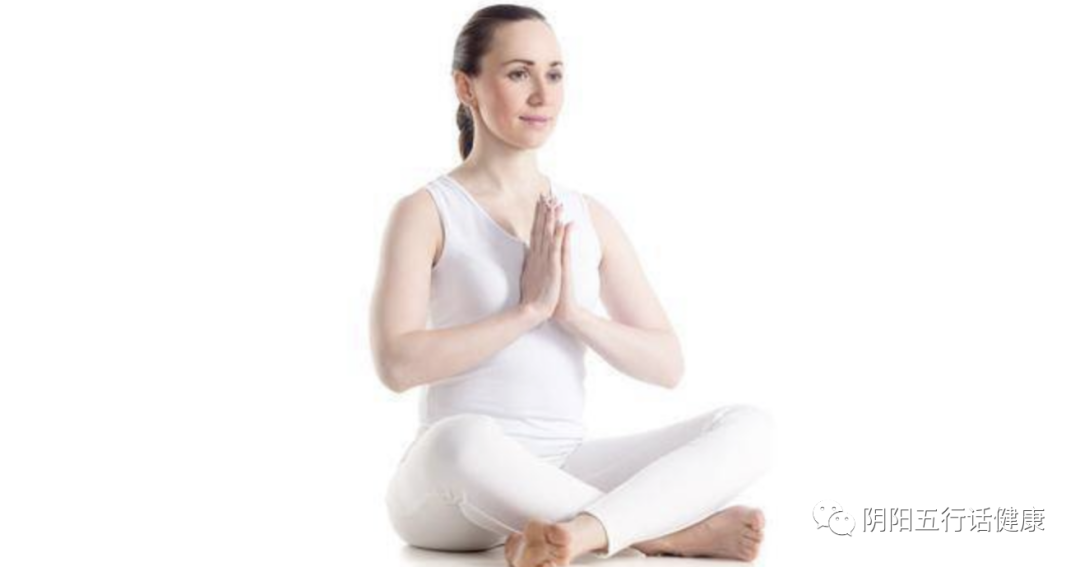
Afterward, it is important to restore and nourish the body.
How can one restore and nourish the body without vigorous exercise?
The breathing methods of both Taoism and Buddhism are very useful.
Here is a brief introduction to three methods.
1. Taoist: Holding Firm Breathing Method
In the “Essentials of Longevity” by Leng Qian, the first of the sitting Eight Pieces of Brocade is “Close your eyes, meditate, and hold firm to calm the spirit.”
This means sitting in a meditative posture or upright position, closing your eyes, placing your hands firmly on your abdomen or thighs, calming down, and breathing slowly.
This is similar to the meditation sitting recommended by national departments.
In fact, the breathing method has a long history.
Tao Hongjing in “Nourishing Life and Extending Life” states: “Breathing through the nose is life; ordinary people cannot control their breath, from morning to night, they should practice continuously, gradually relaxing it, always allowing the nose to inhale and the mouth to exhale, which is called expelling the old and taking in the new.”
“Unceasing” refers to the pauses between breaths in a meditative state, which can be ignored. Just focus on inhaling through the nose and exhaling through the mouth.
In fact, before the Song Dynasty, there was more emphasis on “unceasing.”
In “Nourishing Life and Extending Life,” it is also stated: “Always lying down in a proper position, closing your eyes and holding firm (holding firm means like a baby’s fist, with four fingers pressing the thumb), holding your breath without ceasing, counting to two hundred in your heart, and then exhaling through your mouth, increasing your breath daily.”
This is the lying down breathing method: lying in bed, preferably between 5-7 AM, closing your eyes, holding firm, and adjusting your breath. First inhale, hold your breath for a while, then exhale.
For modern people, holding the breath does not need to be too long; a few seconds is sufficient. It is better to focus on calming the mind and slow, subtle breathing.
In the Song Dynasty, the Taoist master Cao Wenyin stated in the “Song of the Spiritual Source”: “Do not regard holding the breath as the true essence; counting breaths according to diagrams is not the way.”
This opposes placing too much emphasis on holding the breath during breathing adjustment, to avoid mistakes.
Therefore, for the purpose of holding firm breathing to restore vital energy, it is simply about calming oneself down, sitting upright, and adjusting breathing.
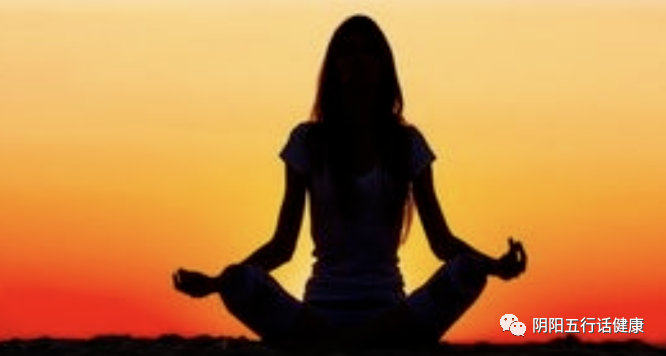
2. Buddhist Observation Breathing Method
The Buddhists also have breathing methods. Previously, I introduced the observation breathing method.
The method is similar to that of Taoism, but the details differ.
This is also the internationally popular “mindfulness” breathing method.
You can sit cross-legged, sit upright on a stool, or even practice standing meditation.
Then, breathe naturally, focus on your breath, and be with your breath.
The focus can be on the tip of the nose or the rise and fall of the abdomen. Keep your heart gentle, only focus on your breath, and do not put any pressure on yourself. Gradually, your breathing will become longer, restoring your vital energy.
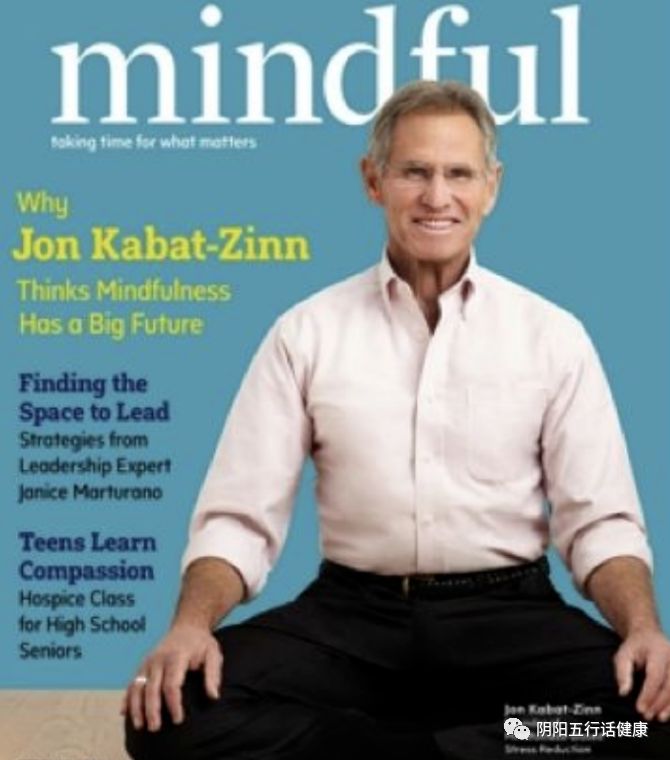
3. Six-Character Formula Breathing Method

The Six-Character Formula Breathing Method has been introduced before, and there are different methods.
There are mainly three types: one is Tao Hongjing’s Six-Character Formula; the second is the General Administration of Sports’ Six-Character Formula; the third is the Shanghai Qigong Research Institute’s Six-Character Formula.
All involve slow inhalation, followed by exhaling using the six-character formula.
Three types of Six-Character Formula correspondences:
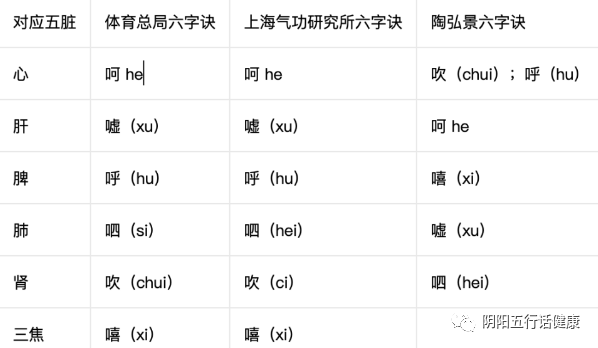
For recovery practice, just focus on the heart and lungs corresponding to the six-character formula.
First, you need to choose a method and then practice consistently:
If you prefer the national system’s Qigong, you can choose the General Administration of Sports version:
Practice: He (呵) – Heart; Si (呬) – Lungs.
If you prefer modern scientific research, you can choose the Shanghai Qigong Research Institute’s Six-Character Formula:
Practice: He (呵) – Heart; Hei (呬) – Lungs.
If you believe that the older, the better, then choose Tao Hongjing’s Six-Character Formula:
Practice: Chui (吹), Hu (呼); Hei (呬).
Do not underestimate the importance of choice.

Why?
Belief is the greatest!
4.Introduction to Hard Qigong
The Eight Great Dragon Palms is a strong Qi transformation hard skill practice method from the Taoist Kunlun School of the South Pole, serving as the foundation for internal and striking skills. During practice, each palm technique employs different intentions, resulting in different effects. This skill primarily emphasizes softness; softness leads to strength, naturally applying reason. The Eight Great Dragon Palms belong to strong skills, mainly aimed at ensuring the body first has smooth Qi and blood, opening meridians and collaterals, to change the quality between tendons, bones, and internal organs, strengthen the physique, enrich internal strength, balance Qi and blood, eliminate weak links that cause diseases in the body, combining movement and stillness, cultivating character and temperament, enhancing vitality, stimulating intelligence, and boosting immune function. Internally practice one breath, externally practice tendons, bones, and skin. This creates a seamless integration of the body, first focusing on hardness, emphasizing the transformation from hard to soft, achieving fundamental changes in physical constitution through prolonged practice, and transitioning to flexibility. Over time, one can achieve natural instinctive abilities, applying them reasonably to exert the body’s inherent power at will. Through practice, one can develop the abilities of hard Qigong, which can prevent and treat diseases, leading to physiological changes in the body and enhancing physical constitution, achieving softness and clarity.
First Palm: Dragon Grinding Disc Palm
This palm has three layers of training methods. When practicing, choose a calm and spacious area.
Preparation Posture
Stand naturally and relaxed, feet shoulder-width apart, arms hanging naturally at your sides, gaze forward, seemingly looking but not really, tongue against the palate, calm the mind, unify body and mind, eliminate distractions from emotions and desires, and achieve unity of spirit, Qi, and demeanor, entering a Qigong state.
(1) Life Skill Training Method:
Starting posture: After entering the Qigong state, direct your intention to the Yongquan (Kidney 1) points in the soles of your feet for a moment, inhale through the nose, drawing Qi from the Yongquan point up to the Xuehai (Spleen 10) points in the knees, simultaneously bringing the knees together, pressing the Xuehai points together, and forming a locked step posture. Then, exhale, imagining the pores of the whole body expanding outward, opening the meridians and pores for a second breath.
Note: The knees must remain locked together from this point onward, as if establishing a solid foundation.
Pause for a moment, then raise both hands naturally from the sides to shoulder height, bending the elbows and turning the palms forward, with the palms facing each other. This posture is the standing palm of the Dragon Grinding Disc.
Effect: Activates Qi and blood, opens meridians, and has a high therapeutic effect on endocrine, adrenal, prostate, and physical weakness diseases.
(2) Sexual Skill Training Method:
On the basis of the standing posture, close your eyes, imagining a round mirror between your hands, observing it through the Tianyan (Yintang) point between your shoulders, looking forward at the mirror about a foot away from your eyes, gathering Qi and focusing your spirit, reflecting outward, perceiving the interactions between the universe and yourself, using your microcosm (the pores of your body) to sense the subtle changes in the macrocosm of the universe, releasing the dragon’s ability to soar and listen quietly. Also, reflect inward, observing the internal flow of the five elements: kidney – bladder – liver – heart – spleen – lung – kidney. The gastrointestinal flow: esophagus – stomach – small intestine – large intestine – anus. The blood circulation flow: from the heart along the outer arteries of the arms, splitting left and right, to the hands, returning through the inner veins to the heart, from the heart down to the lower dantian, splitting left and right to the outer arteries of the legs, returning through the inner veins to the heart. Also, perceive the bones of the whole body. Listen to the sounds of the intestines, the heartbeat, and the flow of blood circulation, inducing the body’s potential and extraordinary functions. Following the principle of natural Tao, one should have no desires to observe the mysteries. “Always have desires to observe the openings, always have no desires to observe the wonders.” This posture is the same as the standing posture, but the focus and intention differ.
Effect: Preserves essence, activates blood, cultivates the spirit, and induces extraordinary functions of the body.
(3) Hard Qigong Training Method:
Continuing from the standing posture, direct your intention to the lower dantian, inhaling Qi from the lower dantian, drawing it up to the Mingmen (GV 4) point, guiding Qi along the spine to the Dazhui (GV 14) point, splitting left and right to fill the hands with internal Qi, holding the breath, keeping the front foot still, shifting the center of gravity to the front foot while keeping the back foot on the ground, moving forward in a circular arc along the ground, as if grinding or moving a sack, with both hands opening like a large gate. With internal Qi filling, unifying essence, Qi, and spirit, under the guidance of intention, the internal Qi drives the body to move collectively, cultivating and mobilizing the unity of thought and form, which is also a method of refining strength. After moving the foot forward, exhale, letting the elbows drop, maintaining the same posture as the standing posture, moving forward half a step or a full step as desired, gathering strength to move as much as possible without pursuing the size of the steps. When essence, Qi, and spirit unite, re-enter the Qigong state, leading with the heart to guide Qi, following the inhalation route from the lower dantian to the hands, with the left foot remaining still, pivoting on the heel, moving the right foot forward, taking a step forward in a grinding motion, exhaling while standing. When re-entering the Qigong state with intention, move forward to the left front step by step, repeating this slowly, with about 50 steps per set, resting briefly after each set, continuing the action. If one can walk 500 steps at once, the strength will be sufficient for breaking bricks and splitting stones in an instant.
Closing the practice:
Keep the knees locked together, lower the hands in front of the lower dantian to form the return to origin hand seal, pause for a moment, then separate the hands to the sides, inhaling and raising them, then turning the palms down and pressing down while exhaling. Separate the knees, keeping the body straight, rub the hands together, rub the face to close the practice.
Note: It is best to warm the body after completing a set, closing the eyes to nourish the heart for a moment, allowing the internal organs and Qi and blood to be replenished and restored.
Effect and requirements: This palm can strengthen tendons and bones, filling Qi and blood in the internal organs. The inhalation route’s effect: the lower dantian is the Qi sea point, located between the intestines, so inhaling and drawing in the abdomen massages and stretches the intestines and five internal organs, while the Mingmen point is between the two kidneys, where true Yin and true Yang reside. The kidneys are located on both sides of the spine, corresponding to the five internal organs, thus allowing Qi to flow in the five internal organs, achieving treatment before illness and strengthening the kidneys and waist, enriching internal strength, changing the quality between tendons and internal organs, enhancing immune function and physical constitution, preserving life and refining form, and preventing and treating diseases. After locking the knees together and closing the practice, inhale, hold the breath, and move forward, twisting the body without losing energy midway, forming a fixed posture before exhaling, maintaining the posture as a standing practice, with the intention of walking forward with each step, inhaling and holding the breath, moving forward.
Second Palm: Dragon Great Strength Palm
This palm has the same structure as the previous one, divided into three layers of practice.
Preparation Posture
Stand naturally and relaxed, with the body relaxed, left leg forward, right leg back, arms hanging naturally at your sides, breathing naturally, tongue against the palate, calming the heart and entering the Qigong state.
(1) Life Skill Training Method
Continuing from the previous posture, after a moment, direct your intention to the Yongquan points in the soles of your feet, inhaling Qi from the Yongquan point up to the Xuehai points in the knees, simultaneously bringing the knees together, forming a three-body locked step posture, with the left foot forward and the right foot back, the center of gravity on the back leg. Raise both hands from the sides to the chest, turning the palms forward, pointing upward, with the tiger mouths facing each other, and the knees locked together, forming a stable triangular shape in the standing posture. Imagine a large iron ball in front of your hands, pushing it forward, relaxing the shoulders and dropping the elbows, holding the chest in and lifting the back, breathing naturally, forming the life skill standing posture.
(2) Sexual Skill Training Method
Continuing from the standing posture, close your eyes, imagining a round mirror between your hands, observing it through the Tianyan point. Imagine that everything in the world is small, while you are particularly large, and through this mirror, see through all things in the world, internally observing the five internal organs, standing as a third party or from the air to view and handle issues, “the bystander sees clearly,” is the method to open the Tianyan point.
(3) Hard Qigong Training Method
Continuing from the three-body standing posture, direct your intention to the lower dantian, inhaling Qi from the lower dantian, drawing it up to the Mingmen point, guiding Qi along the spine to the Dazhui point, splitting left and right to fill the hands with internal Qi, holding the breath, moving the front foot while keeping the back foot on the ground, moving forward in a circular arc along the ground, exhaling while pushing the palms forward, looking at the point where heaven and earth meet, releasing internal strength to push the palms there. Whenever the intention arises, inhale, retract the palms, hold the breath, shift the center of gravity, and move the back foot forward in a circular motion, exhaling and pushing the palms until fully exhaled. During practice, do not rush; practice step by step, with time and sweat, the results will naturally come.
Effect and requirements: The effects are the same as the previous Dragon Grinding Disc Palm. The requirements for walking are that the feet must not leave the ground, retract the palms while inhaling, and exhale while pushing the palms, shifting the center of gravity to the front foot, and moving the back foot in a circular motion. This strengthens the waist and arms, allowing the heart to follow the intention, and the intention leads to the Qi, producing strength.
Closing the practice: The closing method is the same as the first palm.
Third Palm: Dragon Great Strength Palm
Preparation Posture:
Stand naturally and relaxed, feet shoulder-width apart, arms hanging naturally at your sides. Breathe naturally, tongue against the palate, calm the heart and enter the Qigong state.
Practice Method:
Direct your intention to the Yongquan points in the soles of your feet, inhaling Qi from the Yongquan point up to the Xuehai points in the knees, simultaneously bringing the knees together, forming a locked step posture, with both hands raised naturally to the chest, bending the elbows with palms facing down, fingers pointing toward each other. Imagine that there is a thousand-pound iron pillar under your hands, pressing down into the ground for 3 feet while exhaling. When the hands reach the lower abdomen, inhale and lift, imagining pulling the thousand-pound iron pillar from the ground. The force reaches the fingertips, pressing down and pulling up 36 times as one set; extend the arms, palms facing forward, fingers pointing up, imagining a thousand-pound iron pillar in front of each hand, pushing forward while exhaling, pulling back while inhaling, 36 times as one set; extend the hands to the sides, imagining a thousand-pound iron pillar in each hand, pulling back while inhaling, pushing forward while exhaling, for a total of 36 times; after completing the third set, lower the hands from the sides to form the return to origin standing posture.
Closing the practice: The closing method is the same as the first palm.
Effect and requirements: Activates Qi and blood, increases internal strength, and the force reaches the fingertips, useful for immediate application.
Each set can be adjusted according to physical ability, starting from six palms and increasing to 36 times, ensuring the force reaches the fingertips. It is normal for the finger joints to crack during practice; after finishing, relax and move the fingers to relieve tension and restore fatigue.
Fourth Palm: Dragon Lifting the Cauldron
Preparation Posture:
Stand naturally and relaxed, feet slightly wider than shoulder-width, standing upright, hands naturally at the sides, breathing naturally, tongue against the palate, unifying essence, Qi, and spirit, calming the heart and entering the Qigong state.
Practice Method:
When entering the Qigong state, raise both hands naturally to the sides, arms parallel to the shoulders, palms facing down, while exhaling, lower the hands from the sides, squatting down as the Qi is fully exhaled, with the hands forming claws on the inner sides of the feet, palms facing each other. Simultaneously, inhale, raising the hands slowly above the head, as if swallowing a hard object into the abdomen, holding the breath. When the hands are at the sides of the head, perform a supporting lift, with fists facing outward, arms rounded, and toes pressing into the ground, holding the breath for a moment, allowing the force to reach the whole body, exhaling, lowering the hands to the sides, resting for a moment, and then raising the hands again, practicing Qi. This palm should be practiced nine times in one session, gradually increasing.
Closing the practice:
Lower the hands to the lower dantian, bathing and nourishing the heart for a moment, closing the practice in the same way as the first palm.
Effect and requirements: Enriches internal strength, changes the quality of tendons and internal organs, and enhances resistance to strikes, producing the abilities of iron shirt and golden bell.
It is required that the whole body is rounded; those with cerebral ischemia or hypoxia may hold their breath slightly, without forcing it to prevent dizziness.
Fifth Palm: Dragon Supporting the Pillar
Preparation Posture:
Stand naturally and relaxed, feet shoulder-width apart, hands at the sides, breathing naturally, tongue against the palate.
Practice Method:
When entering the Qigong state, take a step forward with the left foot, keeping the right foot in place, forming a three-body posture, with the center of gravity on the back leg for stability. As the left hand rises with the left foot, it should be at nose level, palm facing up, bending the elbow down. The right hand’s thumb points to the navel, palm facing down; the fingers of both hands should be slightly straight, while the other four fingers should be slightly bent, imagining a Qi column between the hands, like a golden hoop, reaching to the heavens. When standing becomes difficult, retract the left foot and step forward with the right foot, switching the hands, moving forward or backward as desired.
Effect and requirements: This palm requires natural breathing, with the tongue against the palate, focusing on intention rather than Qi, enhancing the strength of the legs and the internal energy of the forearms, rooting the legs, allowing the heart to follow the intention, and the intention leads to the Qi, producing strength.
Closing the practice: The closing method is the same as the first palm.
Sixth Palm: Dragon Tongue Palm
Preparation Posture:
Stand naturally and relaxed, feet together, hands at the sides, breathing naturally, tongue against the palate.
Practice Method:
When entering the Qigong state, take a step forward with the left foot, keeping the right foot in place, forming a three-body posture, with the center of gravity on the back leg, distributing 30% of the force to the front and 70% to the back. Raise the left hand, palm facing up, with the index finger slightly straight and the other fingers slightly bent, at nose level, while the right hand is beside the right hip, thumb pointing to the navel, palm facing down. Imagine the lower dantian, inhaling Qi from the lower dantian to the Mingmen point, guiding Qi up the spine to the Dazhui point, splitting left and right to fill the arms and hands with internal Qi; hold the breath, pulling back the front hand with internal strength, pushing the back hand forward. When the two forearms cross in front of the chest, they rub against each other, with the front hand retracting like a claw and the back hand pushing forward like a knife, twisting the arms. When pushing forward, inhale to the fingertips, holding the breath, using the triangular force of the two legs to send strength to the fingertip, exhaling when in position. When the intention arises, guide the Qi from the lower dantian to the fingertips to practice. The front hand extends like a dragon’s tongue; this can be practiced in place or while moving forward or backward. Practicing in place for 100 times will greatly increase internal strength, allowing for the ability to capture and break bricks with immense force.
Effect and requirements: Increases internal strength, changes quality, strengthens tendons and bones, emphasizing the clarity of the three joints, aligning the four extremities, closing the five elements, and focusing on the six harmonies. The force should be from the shoulder to the elbow, hand, and from the hip to the knee to the foot, with the three joints following each other, and the four extremities being: the blood tip, the bone tip, the tendon tip, and the flesh tip. Biting the tongue against the teeth, extending the claws to the crown; the internal five elements and five organs should be calm and not chaotic, with a peaceful heart and Qi like water, uniting the heart with intention, intention with Qi, and Qi with strength for the internal three harmonies, and the external three harmonies being: hands and feet united, elbows and knees united, shoulders and hips united, with punching being a push, and the returning hand resembling a hook is this method.
Closing the practice: The closing method is the same as the first palm.
Seventh Palm: Dragon Kneading Ball
Preparation Posture:
Stand naturally and relaxed, feet together, hands at the sides, breathing naturally, tongue against the palate. Imagine a blue lake in front of you.
Practice Method:
Continuing from the previous posture, take a step forward with the left foot, forming a three-body posture, with the center of gravity on the back leg. Imagine that below the navel is a blue lake, with the left hand in front, aligned with the left foot, palm facing down, and the right hand beside the hip, palm facing down. Imagine that both hands are pressing down on a ball on the calm surface of the lake, pressing the ball into an oval shape on either side of the body, kneading the ball in an oval shape while drawing a circle with the head and eyes following the ball. If you cannot stand, you can change steps in place or step forward or backward. When stepping forward or backward, the same side hand and foot should move together.
Effect and requirements: Enhances internal strength, activates Qi and blood, unifying intention and strength for application, with a strong sense of Qi, initiating the ability to heal diseases. The body should remain upright, with one hand forward and the other back while kneading the ball, using the navel as a reference, drawing circles without crossing the midline, twisting the waist and relaxing the hips, extending the arms and activating the shoulders.
Eighth Palm: Dragon Claw Power
Preparation Posture:
Relax the whole body, standing naturally with feet slightly wider than shoulder-width, standing upright, tongue against the palate, breathing naturally.
Practice Method:
Squat down, adopting a horse stance, bending the elbows and raising the arms, with the elbows beside the hips, palms facing up, resembling dragon claws. Direct your intention to the hands, leading the Qi to generate strength, reaching the fingertips, with both hands curling from the little finger to the thumb, as if crushing an object, drawing circles from side to side, from bottom to top, and from top to bottom, flipping the palms and rotating the wrists. If tired, you can practice standing still, maintaining the horse stance, with the left hand facing up and the right hand facing down, imagining a Qi column between the hands, reaching to the heavens and the earth, resting for a moment to nourish the heart before continuing practice. The movements should resemble a dragon stretching its claws.
Closing the practice:
The closing method is the same as the first palm.
Effect and requirements: Relaxes tendons and activates blood, strengthens the liver and body, enhances overall internal strength, requiring the horse stance to remain, with hands rising and falling as needed, with the hands and wrists rotating with the fingers.

